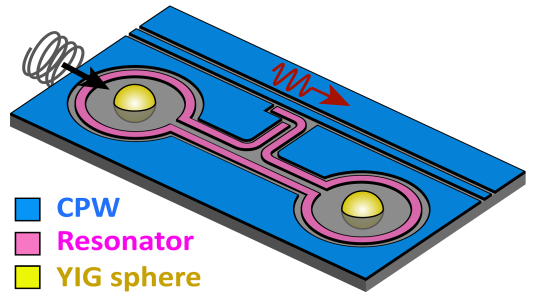Magnetism has played a part in significant discoveries that transform human society, from MRI devices to computer hard disc storage. Magnetic interactions may play a role in conveying quantum information in the nascent field of quantum computing.
 Schematic of the remote magnon-magnon coupling circuit. Two single-crystal YIG spheres are embedded to the NbN coplanar superconducting resonator circuit, where microwave photon mediates coherent magnon-magnon interaction. Image Credit: Yi Li/Argonne National Laboratory.
Schematic of the remote magnon-magnon coupling circuit. Two single-crystal YIG spheres are embedded to the NbN coplanar superconducting resonator circuit, where microwave photon mediates coherent magnon-magnon interaction. Image Credit: Yi Li/Argonne National Laboratory.
Researchers from the US Department of Energy’s (DOE) Argonne National Laboratory have established effective quantum coupling between two distant magnetic devices that may house a form of magnetic excitation known as magnons.
When an electric current creates a magnetic field, these excitations occur. Magnons may share energy and information through coupling. This type of coupling might be beneficial in the development of new quantum information technology devices.
Remote coupling of magnons is the first step, or almost a prerequisite, for doing quantum work with magnetic systems. We show the ability for these magnons to communicate instantly with each other at a distance.
Valentine Novosad, Study Author and Senior Scientist, Argonne National Laboratory
This immediate communication does not necessitate the transmission of a message between magnons whose communication is restricted by the speed of light. It is similar to quantum entanglement, as defined by physicists.
The researchers wanted to design a system that would allow magnetic excitations in a superconducting circuit to communicate with one another at a distance, following up on a 2019 study. This would enable the magnons to serve as the foundation for a quantum computer. Researchers require the particles to be coupled and stay coupled for a long time to build a functioning quantum computer.
Researchers created a superconducting circuit with two tiny yttrium iron garnet (YIG) magnetic spheres inserted in it to obtain a high coupling effect. The magnetic spheres benefit from efficient and low-loss coupling thanks to the material, which enables magnonic excitations.
The two spheres are magnetically coupled to a common superconducting resonator in the circuit, which operates like a telephone line to provide strong coupling even though they are almost a centimeter apart — 30 times the distance of their diameters.
This is a significant achievement. Similar effects can also be observed between magnons and superconducting resonators, but this time we did it between two magnon resonators without direct interaction. The coupling comes from indirect interaction between the two spheres and the shared superconducting resonator.
Yi Li, Study Lead Author and Materials Scientist, Argonne National Laboratory
The extended coherence of the magnons in the magnetic resonator was an additional improvement over the 2019 research. According to Novosad, “If you speak in a cave, you may hear an echo. The longer that echo lasts, the longer the coherence.”
Before, we definitely saw a relationship between magnons and a superconducting resonator, but in this study their coherence times are much longer because of the use of the spheres, which is why we can see evidence of separated magnons talking to each other.
Yi Li, Study Lead Author and Materials Scientist, Argonne National Laboratory
The findings might point to miniaturized quantum devices, according to Li, because the magnetic spins are greatly concentrated in the device. “It’s possible that tiny magnets could hold the secret to new quantum computers,” he added.
The magnonic devices were designed at Argonne’s Center for Nanoscale Materials, a DOE Office of Science user facility.
The research was published on January 24th, 2022, in the Physical Review Letters journal.
Other authors of the research include Volodymyr Yefremenko, Marharyta Lisovenko, Tomas Polakovic, Thomas Cecil, Pete Barry, John Pearson, Ralu Divan, Clarence Chang, Ulrich Welp, and Wai-Kwong Kwok from Argonne National Laboratory. Cody Trevillian and Vasyl Tyberkevych of Oakland University in Michigan also contributed to the research.
The study was financially supported by DOE’s Office of Science (Office of Basic Energy Sciences).
Journal Reference:
Li, Y., et al. (2022) Coherent Coupling of Two Remote Magnonic Resonators Mediated by Superconducting Circuits. Physical Review Letters. doi.org/10.1103/PhysRevLett.128.047701.